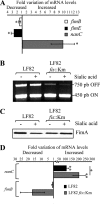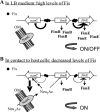Role of decreased levels of Fis histone-like protein in Crohn's disease-associated adherent invasive Escherichia coli LF82 bacteria interacting with intestinal epithelial cells
- PMID: 20118249
- PMCID: PMC2838056
- DOI: 10.1128/JB.01679-09
Role of decreased levels of Fis histone-like protein in Crohn's disease-associated adherent invasive Escherichia coli LF82 bacteria interacting with intestinal epithelial cells
Abstract
The interaction of Crohn's disease (CD)-associated adherent-invasive Escherichia coli (AIEC) strain LF82 with intestinal epithelial cells depends on surface appendages, such as type 1 pili and flagella. Histone-like proteins operate as global regulators to control the expression of these virulence factors. We evaluated the role of histone-like proteins in AIEC reference strain LF82 during infection of intestinal epithelial cells, Intestine-407, and observed that the fis mRNA level was decreased. The role of Fis in AIEC LF82 was determined by studying the phenotype of an LF82 fis::Km mutant. This was the first mutant of strain LF82 that has been described thus far that is unable to express flagellin but still able to produce type 1 pili. The cyclic-di-GMP pathway linking flagella and type 1 pilus expression is not involved in Fis-mediated regulation, and we identified in the present study Fis-binding sites located upstream of the fimE gene and in the intergenic region between fimB and nanC of the fim operon encoding type 1 pili. The major consequence of decreased Fis expression in AIEC bacteria in contact with host cells is a direct downregulation of fimE expression, leading to the preferential ON phase of the fimS element. Thus, by maintaining type 1 pilus expression, AIEC bacteria, which interact with the gut mucosa, have greater ability to colonize and to induce inflammation in CD patients.
Figures







Similar articles
-
The oxidoreductase DsbA plays a key role in the ability of the Crohn's disease-associated adherent-invasive Escherichia coli strain LF82 to resist macrophage killing.J Bacteriol. 2007 Jul;189(13):4860-71. doi: 10.1128/JB.00233-07. Epub 2007 Apr 20. J Bacteriol. 2007. PMID: 17449627 Free PMC article.
-
Regulatory and functional co-operation of flagella and type 1 pili in adhesive and invasive abilities of AIEC strain LF82 isolated from a patient with Crohn's disease.Mol Microbiol. 2003 May;48(3):781-94. doi: 10.1046/j.1365-2958.2003.03468.x. Mol Microbiol. 2003. PMID: 12694621
-
Involvement of lipoprotein NlpI in the virulence of adherent invasive Escherichia coli strain LF82 isolated from a patient with Crohn's disease.Infect Immun. 2004 May;72(5):2484-93. doi: 10.1128/IAI.72.5.2484-2493.2004. Infect Immun. 2004. PMID: 15102755 Free PMC article.
-
Adherent-invasive Escherichia coli: a putative new E. coli pathotype associated with Crohn's disease.Int J Med Microbiol. 2002 Sep;292(3-4):185-93. doi: 10.1078/1438-4221-00201. Int J Med Microbiol. 2002. PMID: 12398209 Review.
-
The Unique Lifestyle of Crohn's Disease-Associated Adherent-Invasive Escherichia coli.J Mol Biol. 2019 Jul 26;431(16):2970-2981. doi: 10.1016/j.jmb.2019.04.023. Epub 2019 Apr 25. J Mol Biol. 2019. PMID: 31029703 Review.
Cited by
-
Genetic components of Escherichia coli involved in its complex prey-predator interaction with Myxococcus xanthus.Front Microbiol. 2023 Dec 5;14:1304874. doi: 10.3389/fmicb.2023.1304874. eCollection 2023. Front Microbiol. 2023. PMID: 38116529 Free PMC article.
-
F9 fimbriae of uropathogenic Escherichia coli are expressed at low temperature and recognise Galβ1-3GlcNAc-containing glycans.PLoS One. 2014 Mar 26;9(3):e93177. doi: 10.1371/journal.pone.0093177. eCollection 2014. PLoS One. 2014. PMID: 24671091 Free PMC article.
-
Professor Arlette Darfeuille-Michaud: the discovery of adherent-invasive Escherichia coli.J Crohns Colitis. 2015 May;9(5):373-5. doi: 10.1093/ecco-jcc/jjv044. Epub 2015 Mar 10. J Crohns Colitis. 2015. PMID: 25759068 Free PMC article. No abstract available.
-
The Crohn's disease-associated Escherichia coli strain LF82 relies on SOS and stringent responses to survive, multiply and tolerate antibiotics within macrophages.PLoS Pathog. 2019 Nov 14;15(11):e1008123. doi: 10.1371/journal.ppat.1008123. eCollection 2019 Nov. PLoS Pathog. 2019. PMID: 31725806 Free PMC article.
-
Genome sequence of adherent-invasive Escherichia coli and comparative genomic analysis with other E. coli pathotypes.BMC Genomics. 2010 Nov 25;11:667. doi: 10.1186/1471-2164-11-667. BMC Genomics. 2010. PMID: 21108814 Free PMC article.
References
-
- Bailey, T. L., and C. Elkan. 1994. Fitting a mixture model by expectation maximization to discover motifs in biopolymers. Proc. Int. Conf. Intell. Syst. Mol. Biol. 2:28-36. - PubMed
-
- Bailey, T. L., and M. Gribskov. 1998. Combining evidence using P-values: application to sequence homology searches. Bioinformatics 14:48-54. - PubMed
-
- Barnich, N., J. Boudeau, L. Claret, and A. Darfeuille-Michaud. 2003. Regulatory and functional co-operation of flagella and type 1 pili in adhesive and invasive abilities of AIEC strain LF82 isolated from a patient with Crohn's disease. Mol. Microbiol. 48:781-794. - PubMed
Publication types
MeSH terms
Substances
LinkOut - more resources
Full Text Sources
Medical
Miscellaneous

